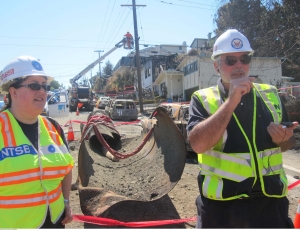The California Public Utilities Commission and Pacific Gas and Electric agreed on a penalty of at least $3 million for failure to supply all its records for pressure tests of natural gas pipelines in high-consequence areas (HCA) as requested earlier this month.

The deal was reached March 24 during a CPUC �Order to Show Cause� hearing on the matter. The commission will discuss the order Monday, March 28, before an administrative law judge with a final decision made �thereafter,� says the CPUC.
The CPUC�s Executive Director Paul Clanon says the stipulated outcome would fine PG&E $6 million in shareholder funds for failure to comply with the CPUC�s order and would require PG&E to operate under a compliance plan to complete the CPUC�s directive. Of the $6 million, $3 million would be immediately payable to the state�s general fund, and $3 million would be suspended if PG&E hits milestones in its records search process and completes its records search for information on grandfathered pipes by Aug. 31.
PG&E failed to satisfy CPUC�s terms under a March 15 deadline to provide data on its pipeline system. The utility says it supplied records for pressure tests or historical operating pressure for more than 90% of its 1,805 miles of natural gas transmission pipelines in HCAs. The CPUC shot back that it�s the �historical operating pressure� records that violates its demand.
CPUC directed PG&E on Jan. 3 to undertake urgent National Transportation Safety Board (NTSB) safety recommendations following the Sept. 9, 2010 San Bruno explosion. PG&E says it started right away in reviewing its records and on March 5 moved �tens of thousands of boxes� of documents to the Cow Palace arena in South San Francisco, assigning hundreds of employees and contractors to sift through piles.
A day after the deadline, CPUC�s Clanon sent a letter to Christopher Johns, PG&E president, telling the utility that the commission didn�t find �traceable, verifiable and complete records� that were required in the first place.
In PG&E�s 154-page report on Maximum Allowable Operating Pressure(MAOP) validation, a paragraph on page 7 reads: �PG&E understands the intent to be to identify reliable records confirming the performance of a pressure test or the determination of MAOP based on the historical high operating pressure.�
�PG&E has no legitimate or good faith basis for the conclusion quoted in the report,� writes Clanon. �As you well know, the whole purpose of the NTSB�s urgent safety recommendations, and for the commission�s directive to PG&E, was to find, to the extent possible, a basis for setting MAOP by means other than the grandfathering method described in PG&E�s response.�
PG&E will tell its side of the story at the hearing. Penalties and fines for not complying range from $20,000 per day for a single violation up to $1 million.
PG&E was put on the defensive following the blast that killed eight people and destroyed 38 homes.
NTSB�s January recommendations were based on its findings that PG&E�s actual installed pipe in Line 132, the line in San Bruno that ruptured, was not consistent with its as-built drawings.
Utility drawings showed seamless pipe; investigators founds welded sections.
Overall, the CPUC says PG&E �appears to have attempted merely to justify the practice of setting MAOP for pre-1970 pipelines based entirely on historical high operating pressure.� The San Bruno pipeline was installed in 1956.
�I can understand some of the CPUC�s perspective though I don�t speak for them,� says Richard Kuprewicz, a pipeline safety consultant in Redmond, Wash. �I�ve seen a lot of pipeline operations in my almost 40 years and certain records or information [don�t] get lost, missing, misplaced or destroyed no matter how old�The CPUC or the public [may] decide the operator has lost control of their operations and I hope we don�t get to that point.�
PG&E told the CPUC that it would continue to search for the missing as-built drawings, though it may take the rest of this year. The utility also presented an in-line inspection and field-test plan with �smart pigs� and new camera technologies, as well as plans for additional pressure testing and pipeline replacement.
In other news, Senators Dianne Feinstein and Barbara Boxer (both D-Calif.) asked the federal Pipeline and Hazardous Materials Safety Administration to close a loophole allowing utilities to not report most instances in which a pipeline is operated above the MAOP.
The senators told Cynthia Quarterman, PHMSA administrator, that even though federal law requires each operator of a transmission pipeline facility to submit a �written report on any condition that is a hazard to life, property or the environment,� regulations only require pipeline operators to report accidental cases in which the MOAP is exceeded if the operators are unable to correct the malfunction within five days.
�Nowhere do we find any obligation to report intentional pressure spikes over the MOAP,� write the senators, who add that they found mention of this loophole while reviewing regulations that could prevent another San Bruno event.


Post a comment to this article
Report Abusive Comment